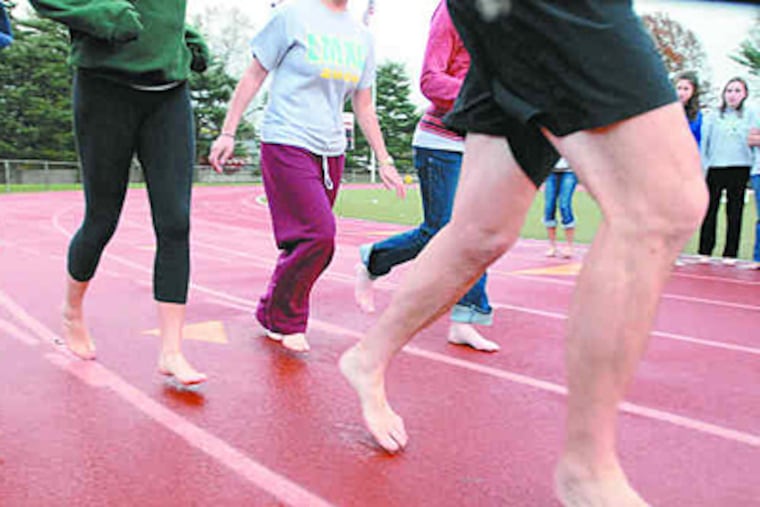Running barefoot is gaining ground
They are passionate. They report being free of injury. They endure - in some cases relish - the puzzled stares of passersby.

They are passionate. They report being free of injury. They endure - in some cases relish - the puzzled stares of passersby.
They are people who run barefoot, or in slipper-thin "minimal shoes," and increasingly they have a few scientists in their corner.
Barefoot runners tend to land on the balls of their feet, rather than smacking the ground heel-first, generating an impact that may be less harmful to the body, a team of researchers is reporting today in the journal Nature.
Last month another study found that runners wearing shoes experienced greater torque in the knee and hip. While neither study looked at rates of injury, the authors of the Nature paper say the forefoot-first style may reduce tibial stress fractures and a painful condition called plantar fasciitis.
The findings are welcomed by those runners who have long since given up their traditional, thick-soled running shoes - chief among them Lancaster County resident Christopher McDougall, author of the popular book Born to Run.
Still, the authors of the Nature paper cautioned that if people want to run forefeet-first - whether they are barefoot or wearing minimal shoes - they should proceed gradually.
A similar warning was sounded by Havertown-based surgeon Nicholas DiNubile, who has been the orthopedic consultant for the Pennsylvania Ballet for nearly 30 years. Even if the forefoot running style prevents certain kinds of injuries, it could increase others, he said after reviewing the research at The Inquirer's request.
Landing on the forefoot puts more load on the calf and Achilles tendon, DiNubile said.
"Whereas some will get very strong and do great, others will break down in that area," he said.
The authors of the Nature paper, led by Harvard evolutionary biologist Daniel Lieberman, measured the forces generated in three situations: barefoot runners landing heel-first and forefoot-first, and shoe-wearing runners landing heel-first.
The peak force was the same in all three. But the impact felt by barefoot, heel-first runners was much more sudden. Heel-first runners in shoes fared much better, but the forefooters experienced the impact most gradually.
Both bone and soft tissue can be more prone to injury when subjected to sudden loads, said Irene S. Davis, one of the study's coauthors and a professor in the physical-therapy program at the University of Delaware.
In the forefoot running style, the runner's heel still touches the ground, but this occurs a split-second after the initial impact of the forefoot.
Stephen Piazza, a Pennsylvania State University associate professor of kinesiology who reviewed the research, said this style made greater use of the foot's springlike arch and also the calf muscles. He urged further study, as did Davis and Lieberman.
Yet both of them have already made the switch themselves to the forefoot style, either barefoot or with minimal shoes.
(One manufacturer of these shoes, Vibram, helped fund the study, but it did not look at these shoes, and the authors told the Associated Press that the company played no role in the research.)
Davis said she switched running styles because she was "inspired" by McDougall's book.
In Born to Run, the author accuses the makers of traditional running shoes of causing injury. A statement from one company, New Balance, countered that shoes can "correct biomechanical abnormalities and risk factors therefore minimizing the likelihood of injury."
A company spokeswoman said she knew of no head-to-head comparison between barefoot and shoe-clad running but said, "At a minimum, shoes protect the athlete from rock, debris, glass, etc. on the road."
Lieberman said barefoot runners did just fine if they built up protective calluses.
McDougall, whose book explores the running prowess of the Tarahumara people of Mexico, said barefoot running clubs were springing up across the country - Los Angeles, San Francisco, Boston.
"It has grown faster than I think anyone has been able to keep track of," McDougall said.
He does not know of one yet in Philadelphia, but several members of a group called the Fishtown Beer Runners have taken the leap.
Among them is Dave Maver, who runs either barefoot or in Vibram's minimal shoes, called FiveFingers.
"It was this wonderful sort of sensation," Maver said of his first experience. "Your feet all of a sudden become a tool to interact with the environment. I was in no pain, which was just so great."